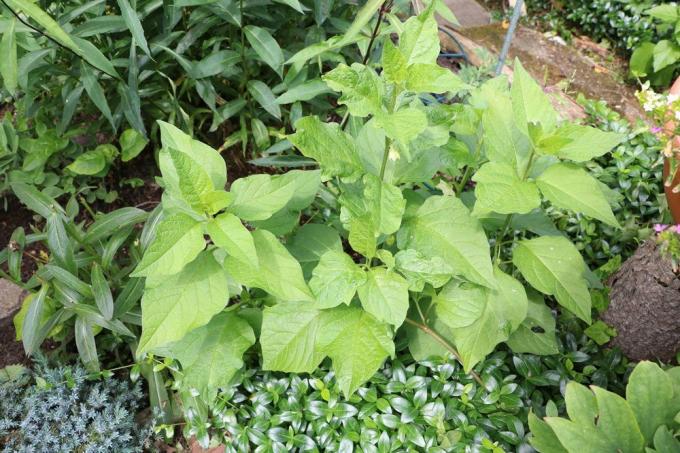
table of contents
- Chinese lantern flower (Physalis alkekengi)
- Above-ground parts of plants
- Berry
- Subterranean plant parts
- Toxicity
- For children
- For animals
The lantern flower, botanically Physalis alkekengi, belongs to the plant genus of the bladder cherry (Physalis) from the nightshade family (Solanaceae). A relative of the lantern flower is the cape gooseberry, botanically Physalis Peruviana. While the berries of the lantern flower are not suitable for consumption, the fully ripe berries of the Cape gooseberries, which are often offered as physalis in supermarkets, are eaten without any problems will.
Chinese lantern flower (Physalis alkekengi)
The lantern flower is an ornamental plant. Its name comes from the lampion-like calyx that surrounds the fruit. During the ripening time of the berry inside the chalice, it glows intensely in orange-red. Since the plant is very undemanding, it can be found more and more often in home gardens. But be careful, lantern flowers are purely ornamental plants and not suitable for consumption, as they are slightly toxic, according to the Bonn poison control center.

Above-ground parts of plants
The green parts of the plant in Chinese lantern flowers contain bitter substances that can irritate the gastrointestinal tract. If diarrhea and / or vomiting occurs, it may be necessary to consult a doctor. Are responsible for the symptoms of intoxication Steroid lactones in the above-ground parts of the plant. They are found in all parts of the plant with the exception of the berries.
Berry
The berries of lantern flowers do not contain any Steroid lactones, but the toxins can easily be carried over to their fruits. Because on the inside of the parchment-like cup that surrounds the berry, there are glands that give off an extremely bitter and poisonous juice. If the calyx is opened with the fingers, the juice of the glands is transferred to the berry, which can lead to symptoms of poisoning if larger quantities of the berries are consumed. Once the juice has been transferred, the berries no longer taste sweet and sour, but extremely bitter. Therefore, the berry is usually spit out quickly.
If larger quantities of the berries are nevertheless consumed, this can lead to symptoms of poisoning similar to those of the deadly nightshade. Symptoms include nausea, sweating, and heart problems.
Tip: Regardless of the transferred juice, as with all nightshade plants, the unripe fruits of the lantern flower are poisonous to humans if they are eaten in large quantities.
Subterranean plant parts
The roots of plants contain tropine derivatives that are toxic to humans and those that are toxic to humans.
Toxicity
For children
Small children in particular feel magically attracted by the glowing goblets. But also for children the consumption of the berries of lantern flowers seems to be rather harmless. The Munich poison hotline sees no risk of poisoning for children. The Styrian capital Graz lists the plants in the butterfly "poisonous plants" in the category "harmless and largely non-toxic". They are even considered child-friendly there.
The Poison Information Center North (GIZ-Nord) indicates with reference to medical literature that in children who have eaten one to ten berries, have had slight vomiting, slight stomach pain or slight diarrhea are.
Tip: Since it remains unclear whether the consumption of the berries is safe for children, it is better to educate children about the danger posed by the plant.
For animals
Chinese lantern flowers for Pets are dangerous cannot be clearly clarified. The lantern flower is not listed as a poisonous plant in the database of the Institute for Veterinary Pharmacology and Toxicology at the University of Zurich. Elsewhere in the database, the berries of the lantern flower are labeled as edible.

Tip: If your pet has nibbled on the berries and has symptoms, you should definitely consult a veterinarian.
sources
- http://www.gizbonn.de/174.0.html
- https://www.botanikus.de/Botanik3/Ordnung/Lampionsblume/lampionsblume.html
- https://www.lw-heute.de/-giftig-delikat
- https://www.graz.at/cms/dokumente/10141641_7749020/6f26efbd/Giftige%20Pflanzen.pdf
- http://www.vetpharm.uzh.ch/reloader.htm? giftdb / plants / 0223_bot.htm? inhalt_c.htm
